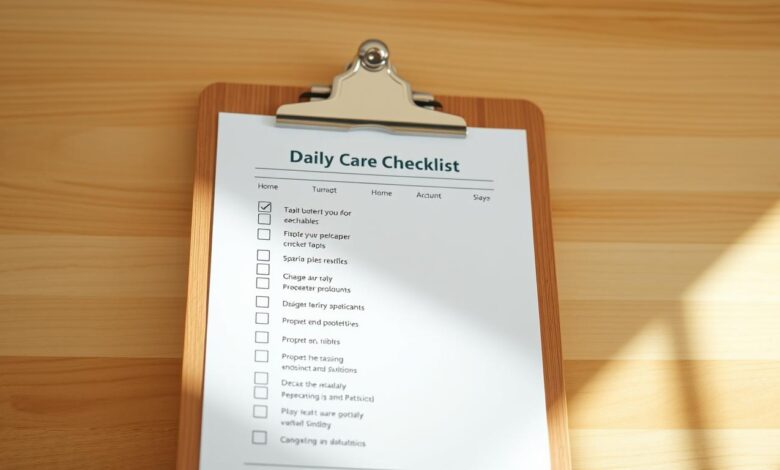The Ultimate Daily Pet Care Checklist

Ever think if your pet’s routine is complete? A good daily care plan is more than just feeding and walks. It’s key to their health and happiness.

A pet care checklist keeps you on track. It covers everything from brushing teeth to checking paws. It works for dogs, cats, and small mammals alike. Following this routine helps catch health problems early and strengthens your bond.
This checklist fits any lifestyle. It helps you meet your pet’s needs, whether they’re furry, feathered, or scaled. Let’s create a routine that keeps your pet happy every day.
Understanding Why Your Pet Needs a Consistent Care Schedule
A consistent care routine is more than just feeding or grooming. It’s the base of their health. Let’s see how daily routines make pets happy and healthy.
The Physical Benefits of Regular Pet Care
Feeding, exercise, and vet visits keep your pet’s body strong. Eating at the same time helps digestion and prevents obesity. Grooming, like brushing teeth or trimming nails, stops infections and joint problems.
These habits help pets live longer. Simple things like daily walks or playtime boost energy and muscle.
How Daily Routines Support Your Pet’s Mental Health
Predictable schedules reduce stress. Pets feel secure when they know what’s next, like meal times or play. A study by the American Veterinary Medical Association shows routines cut anxiety behaviors.
Pet wellness tips often mention this. A structured day gives pets a sense of safety. Routine also helps with separation anxiety, making transitions easier.
Building Trust Through Consistent Care Practices
Sticking to a care plan shows your pet you’re reliable. Brushing, feeding, or cuddling at set times builds trust. Over time, these moments become special bonding times.
Pets learn to expect care, making vet visits easier. This consistency builds loyalty and reduces resistance during grooming or medication.
Essential Morning Pet Care Rituals to Start the Day Right
Starting your day with a daily care routine for your pet makes them feel safe and full of energy. Wake them up softly or with a light touch. A quick health check—looking at their eyes, ears, and energy—only takes a minute but helps spot problems early.
Take your pet outdoors for a bathroom break. Give them praise or a small treat.
Feed a measured morning meal in their favorite bowl or interactive feeder. Don’t overfeed to avoid digestion problems.
Include a short pet exercise routine, like a 15-minute walk or play session. Adjust based on their age and breed—puppies might need gentle play, while active breeds thrive on brisk walks.
Mornings are great for building positive associations. Use upbeat tones and calm movements to reduce anxiety. For busy schedules, combine tasks: talk to your pet while preparing meals or brushes. A consistent start sets the tone for the day, reinforcing trust and routine.
Flexibility is key. If your pet resists exercise, try shorter sessions spaced throughout the morning. The goal is to create a calm, predictable start that supports their physical and emotional well-being. Every step in this routine strengthens your bond while laying the groundwork for a happy, healthy day.
Daily Care Routine for Your Pet: The Ultimate Checklist
Every pet parent needs a simple guide to keep their pet happy and healthy. This pet care checklist makes daily tasks easy. It combines pet wellness tips with practical steps. Let’s make routine care a breeze.
Morning Care Essentials
Begin with these quick morning steps:
- Wake your pet gently—use a soft voice or light touch
- Check water bowls and refill with fresh water
- Feed measured portions per your vet’s guidelines
- Give morning meds, noting administration times
- Quick leash walks or indoor play for 10 minutes
Midday Check-ins and Care
Even when busy, check in at least twice daily:
- Midday feeding—split meals to avoid overeating
- 5-minute bathroom breaks if home, or arrange pet sitter visits
- Interactive toys for mental stimulation
Evening Care Routine
Wind down with these evening tasks:
- 30-minute outdoor time or indoor play
- Brushing and coat inspections for health signs
- Second dose of medications if prescribed
- Short training sessions for bonding
Before-Bed Pet Care Practices
End the day with calm routines:
- Final potty break 1 hour before bed
- Teeth brushing with pet-safe toothpaste
- Bedtime snack if vet-approved
- Inspect sleeping area for comfort and safety
Make this pet care checklist your own. Download our free printable template at [BrandName.com] for easy tracking. Small changes can make a big difference in your pet’s health.
Mastering Your Pet’s Nutrition and Hydration Needs
A good pet nutrition guide helps your pet stay healthy and happy. It’s all about the right food and water. Begin by talking to your vet to make a meal plan that fits your pet’s needs.

Creating a Balanced Feeding Schedule
Make a meal plan that matches your pet’s age and how active they are. Dogs and cats need different amounts of food. Puppies eat more often, while older pets eat less. Always check the food label for age-specific advice.
Portion Control and Weight Management Tips
- Use a measured cup for kibble to avoid overfeeding.
- Weigh your pet monthly and adjust portions if needed.
- Choose high-quality foods with protein as the first ingredient.
Monitoring Water Intake Throughout the Day
Make sure your pet always has fresh water. Cats like water from a fountain. Look out for dry gums or tiredness, signs of dehydration. Adding wet food to meals helps keep them hydrated.
Treating Your Pet Responsibly
Treats should not be more than 10% of your pet’s daily calories. Choose carrot sticks or apple slices over store-bought treats. Stay away from chocolate, grapes, and onions, as they are harmful.
Daily Exercise Requirements Based on Your Pet’s Type and Age
Your pet’s pet exercise routine is key to their pet health maintenance. Dogs, cats, and small animals each need specific activities to stay healthy and happy. Let’s explore what’s best for your furry, feathered, or scaly friend.
- Dogs: Active breeds like Golden Retrievers need 60+ minutes of walks or play. Senior dogs may require shorter, gentle walks. Use puzzle toys to engage indoor pups.
- Cats: Kittens thrive with 15-minute play sessions twice daily. Older cats might prefer slower laser pointers or feather toys. Rotate toys to keep them interested.
- Small mammals (guinea pigs, rabbits): Daily supervised playtime in a safe enclosed space. Hamsters enjoy wheel running, while rabbits benefit from obstacle courses.
- Birds and reptiles: Parrots need wing flapping and climbing; snakes require hiding spots and temperature zones for natural movement.
Adjust your routine for life stages. Puppies under 6 months need short bursts of activity, while seniors may need arthritis-friendly stretches. Even 10-minute interactive games count toward mental stimulation, which boosts overall well-being.
Busy? Try these tips: Combine walks with your own errands, use automatic toys for cats, or enroll in doggy daycare. Always watch for signs of exhaustion—panting, limping, or reluctance to move—and adjust.
Incorporate these guidelines into your daily schedule, and watch your pet’s energy and happiness soar. A consistent routine strengthens bonds and supports lifelong health.
Maintaining Proper Pet Hygiene Without the Stress
Keeping your pet clean doesn’t have to be hard. A regular pet grooming schedule and gentle pet hygiene practices make life easier for both you and your pet. Begin with small steps and make each one a good experience.
Daily Brushing and Coat Maintenance
Brush your pet’s coat every day to stop matting and spread skin oils. Use slicker brushes for long-haired dogs or rubber gloves for cats. Give treats to make it a positive thing. For thick coats, do 5-minute sessions twice a week to avoid stress.
Paw Care and Cleaning
- Check paws daily for dirt or injuries.
- Wipe between paw pads with a damp cloth weekly.
- Trim nails every 3-4 weeks with sharp clippers.
Keep sessions short and end with praise to keep your pet calm.
Dental Health Routine
Brush teeth 3 times a week with pet-safe toothpaste. Let your pet sniff the brush first. If brushing is hard, use dental chews or water additives. Being consistent saves vet visits.
Managing Shedding and Dander
Use a vacuum with a HEPA filter every day. Run a lint roller over furniture and use microfiber cloths to catch dander. Air purifiers with activated carbon filters also help. A weekly bath with hypoallergenic shampoo can help too.
Add these steps to your daily routine slowly. Celebrate small victories and adjust as needed. Your pet’s health and happiness depend on your care, and so does your enjoyment together.
Quick Daily Health Checks to Catch Problems Early
Spotting health issues early is simple with daily checks that fit into your pet care checklist. These quick inspections are part of routine pet health maintenance and take just a minute each day.
- Inspect eyes for cloudiness or discharge.
- Check ears for odor, redness, or debris.
- Look inside the mouth for bad breath or swollen gums.
- Run hands over the body to feel lumps or unusual bumps.
- Watch how they move—hesitation to jump or limp?
- Track appetite changes or excessive thirst.
Note anything unusual. Sudden lethargy, loss of interest in food, or difficulty breathing deserve immediate vet attention. Use a pet care checklist to log findings each day.
- Keep a calendar with notes on behavior changes.
- Mark dates of vaccinations or vet visits.
- Download our free printable checklist for clear reminders.
Early detection saves time and stress. Small daily efforts turn into big health wins. Your close attention helps your pet stay healthy longer. Make these checks a habit—they’re fast and could spot problems before they worsen.
Adapting Your Pet Care Routine for Special Circumstances
Life changes, and your daily care routine for your pet must flex with it. Whether your furry friend is aging, facing health issues, or venturing into new environments, thoughtful adjustments ensure their comfort and safety. Here’s how to tailor care without compromising pet wellness tips.

Adjustments for Elderly Pets
- Reduce exercise intensity: Swap long walks for gentle strolls or indoor play.
- Split meals into smaller portions to aid digestion and energy levels.
- Provide orthopedic bedding and ramps for elevated spaces.
Accommodations for Pets with Health Conditions
- Set medication reminders and track dosages in a calendar or app.
- Modify feeding times around treatments to avoid stomach upset.
- Keep vet contact info visible and accessible for emergencies.
Weather-Related Modifications
- In heatwaves, schedule walks for cooler mornings/evens and provide shaded outdoor areas.
- During cold snaps, layer with pet-safe sweaters and wipe paws after walks.
- For storms, create a calm “safe zone” with familiar blankets and toys.
Travel and Vacation Prep
- Pack a travel kit with medications, favorite toys, and a recent photo.
- Leave familiar bedding at home to ease reentry after trips.
- Notify pet sitters of feeding schedules and any health needs.
Always observe your pet’s reactions and adjust gradually. Small changes today prevent bigger challenges tomorrow.
Embracing the Joy of Pet Parenthood Through Mindful Daily Care
Your daily pet care checklist is more than just tasks. It’s a way to connect deeper with your pet. Every moment, like brushing their fur or checking their paws, lets you see how they’re feeling. These routines help both you and your pet feel less stressed.
By being present in these moments, you can catch small changes early. This builds trust through consistency. It’s a beautiful way to strengthen your bond.
Make daily tasks fun by adding praise or treats. Turn feeding into a special time by eating together. Watching them play or rest reminds you of their importance in your life.
Getting kids involved in simple tasks like filling water bowls teaches them responsibility. It also brings families closer together.
Customize your pet care checklist to fit your pet’s unique needs. A senior dog might need softer places to nap, while an active cat needs more playtime. It’s not about being perfect; it’s about being present.
When you tailor these routines to your pet, they show your shared life. Every task on your checklist is a step towards creating happy memories. Mindful care turns daily chores into acts of love.



